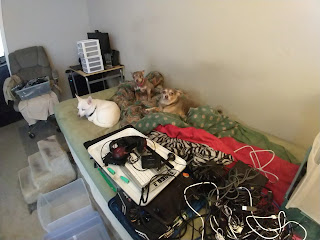In thinking about cutting down my load, I’ve come up with an idea. Stark has a forward SD slot under its trackpad that usually houses a simple slug that Dell pre-installed. Swapping this with my spare MicroSD and a SD adapter is one less thing to keep track of.
Experimenting with this idea, I also opted to try a few drives in my standard kit.
My old 1TB Transcend drive works pretty snazzy. This is one of those old green laced grey “Milspec” framed drives connected with an old Samsung MicroB 3.0 cable.
root@stark:~# dd if=/dev/zero of=/media/terryp/Transcend/dd.img bs=1M count=10241024+0 records in
1024+0 records out
1073741824 bytes (1.1 GB, 1.0 GiB) copied, 1.80687 s, 594 MB/s
root@stark:~# rm /media/terryp/Transcend/dd.img
Generally, I use this drive for backing up my laptop since it’s one of the better portable drives that I own. Give or take how old it is, lol. This drive is also formatted exFAT unlike the other drives, which are all FAT32.
Here’s the 128G SanDisk Ultra flash drive I bought some years back:
root@stark:~# dd if=/dev/zero of=/media/terryp/DE47-D1C8/dd.img bs=1M count=10241024+0 records in
1024+0 records out
1073741824 bytes (1.1 GB, 1.0 GiB) copied, 14.8877 s, 72.1 MB/s
root@stark:~# rm /media/terryp/DE47-D1C8/dd.img
Which mostly serves for shuffling files around, since it’s a decent capacity for a small size.
Here’s a pair of USB drives from Microcenter free coupons. A slower 32G drive labelled USB 3.0 and a faster 16G drive labelled USB 3.1; the translucent cases look like the board designs are the same.
root@stark:~# dd if=/dev/zero of=/media/terryp/USB DISK/dd.img bs=1M count=10241024+0 records in
1024+0 records out
1073741824 bytes (1.1 GB, 1.0 GiB) copied, 196.081 s, 5.5 MB/s
root@stark:~# rm /media/terryp/USB DISK/dd.img
root@stark:~# dd if=/dev/zero of=/media/terryp/USB DISK/dd.img bs=1M count=1024
1024+0 records in
1024+0 records out
1073741824 bytes (1.1 GB, 1.0 GiB) copied, 32.868 s, 32.7 MB/s
root@stark:~# rm /media/terryp/USB DISK/dd.img
root@stark:~# dd if=/dev/zero of=/media/terryp/DE47-D1C8/dd.img bs=1M count=1024
The 32G which is slow, serves as my offline video cache for my tablet. The 16G I just got tonight courtesy of another coupon.
And here’s the 32G TF/MicroSD card that caused this line of testing, also from Microcenter.
root@stark:~# dd if=/dev/zero of=/media/terryp/32 GB/dd.img bs=1M count=1024
1024+0 records in
1024+0 records out
1073741824 bytes (1.1 GB, 1.0 GiB) copied, 95.4401 s, 11.3 MB/s
root@stark:~# rm /media/terryp/32 GB/dd.img
Hmm. I think that I will just leave the card in there. It’s pretty unlikely to get knocked out, and I don’t expect it would cause notable impact to the battery life. Keep the USB adapter in my usual travel gear, but keep the card in Stark.

